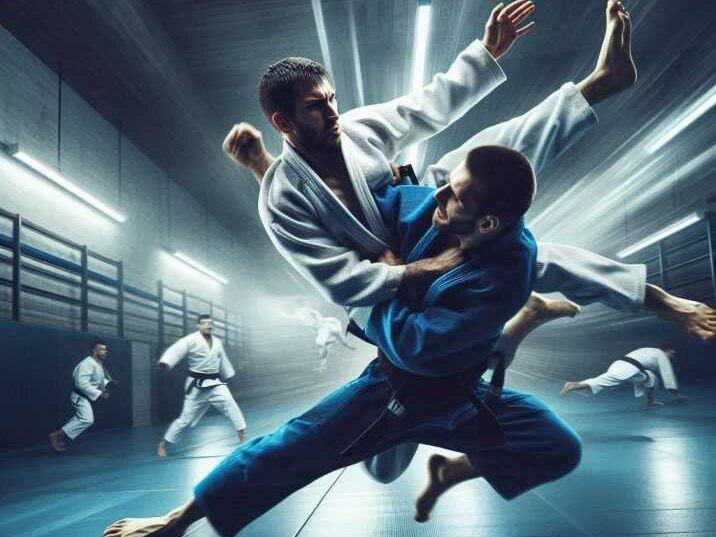Introduction
Table of Contents
In the realm of combat sports, few disciplines capture the imagination and admiration of enthusiasts quite like Sambo and Wrestling. Both sports boast rich histories, rigorous training methodologies, and a global following of dedicated practitioners. Whether you’re a seasoned athlete, a martial arts enthusiast, or someone considering which path to take, understanding the nuances of Sambo and Wrestling can help guide your decision.
In this comprehensive blog post, we’ll delve into the origins, techniques, rules, and cultural significance of both Sambo vs Wrestling. By the end, you’ll have a clear understanding of what sets these two combat sports apart and which might be the best fit for you.
Table of Contents
- History and Origins
- Sambo
- Wrestling
- Techniques and Styles
- Sambo Techniques
- Wrestling Techniques
- Training and Competition
- Training Regimens
- Competitive Structures
- Cultural Significance
- Sambo in Russia and Beyond
- Wrestling’s Global Impact
- Choosing Between Sambo and Wrestling
- Fitness and Conditioning
- Self-Defense
- Competitive Opportunities
- Conclusion
History and Origins of Sambo and Wrestling
Sambo
Sambo, short for “SAMozashchita Bez Oruzhiya” (self-defense without weapons), originated in the Soviet Union in the early 1920s. It was developed to enhance the hand-to-hand combat skills of the Red Army. Viktor Spiridonov and Vasili Oshchepkov, two key figures in Sambo’s creation, drew inspiration from a variety of martial arts, including judo, jujitsu, and native Russian wrestling styles. Over the decades, Sambo evolved into a sport with distinct disciplines: Sport Sambo, similar to amateur wrestling and judo, and Combat Sambo, which includes striking techniques.

Wrestling
Wrestling is one of the oldest known sports, with a history dating back to ancient civilizations such as Mesopotamia, Egypt, and Greece. The sport has evolved significantly over millennia, giving rise to various styles, including Greco-Roman, Freestyle, and Folkstyle. Wrestling made its debut in the modern Olympic Games in 1896 and has remained a staple of the competition ever since. Its emphasis on grappling, throws, and pins makes it a dynamic and physically demanding sport.
Techniques and Styles of Sambo and Wrestling
Sambo Techniques
Sambo is renowned for its comprehensive approach to combat, incorporating throws, ground grappling, and submission holds.
Some key techniques include:
Throws and Takedowns: Sambo practitioners use a variety of throws to bring opponents to the ground. These include:
- Hip Throws (O-Goshi, Koshi Guruma): These involve lifting the opponent over the hip and throwing them to the ground. The practitioner uses their hip as a pivot point.
- Leg Sweeps (Deashi Barai, Sasae Tsurikomi Ashi): These techniques involve sweeping the opponent’s legs out from under them, causing them to fall. The practitioner times the sweep with the opponent’s movement to off-balance them effectively.
Ground Control: Techniques focus on maintaining dominant positions and controlling the opponent on the ground.
Key aspects include:
- Pinning (Kesa Gatame, Side Control): Keeping the opponent’s shoulders on the mat, restricting their movement, and applying pressure to tire them out.
- Transitioning (Guard Passing, Mount): Moving from one dominant position to another to maintain control and set up submissions.
Submissions: Arm locks, leg locks, and chokeholds are integral parts of Sambo, allowing for decisive victories without strikes.
Common submissions include:
- Arm Locks (Americana, Kimura): Applying pressure to the elbow joint to force the opponent to submit.
- Leg Locks (Kneebar, Heel Hook): Targeting the knee or ankle joints to force a tap-out.
- Chokeholds (Rear Naked Choke, Guillotine): Compressing the opponent’s airway or blood flow to induce a submission.
Striking (Combat Sambo): In Combat Sambo, practitioners can use punches, kicks, and knee strikes, making it a versatile and formidable discipline.
Techniques include:
- Punches (Jab, Cross): Basic striking techniques using the fists.
- Kicks (Roundhouse Kick, Front Kick): Strikes delivered using the legs to target various parts of the opponent’s body.
- Knee Strikes: Using the knees to strike the opponent, often in close combat situations.
Wrestling Techniques
Wrestling emphasizes control, strength, and technique, with a focus on taking opponents down and securing pins.
Key techniques include:
Takedowns: Single-leg and double-leg takedowns are fundamental moves used to bring opponents to the mat.
Key techniques include:
- Single-Leg Takedown: The wrestler grabs one of the opponent’s legs and lifts it while driving forward to take them down.
- Double-Leg Takedown: The wrestler grabs both legs of the opponent and drives them backwards to take them to the ground.
Clinching and Throws: Wrestlers use body locks and throws to gain advantageous positions.
Techniques include:
- Body Lock: Grabbing the opponent around the torso to control their movement and set up a throw or takedown.
- Throws (Suplex, Hip Toss): Techniques where the wrestler lifts and throws the opponent, using leverage and strength to gain control.
Pins: The objective is often to pin the opponent’s shoulders to the mat, resulting in a win.
Key techniques include:
- Half Nelson: One arm is slipped under the opponent’s arm and the hand is placed on the back of their neck, using leverage to turn them onto their back.
- Cradle: The wrestler locks hands around the opponent’s head and one leg, forcing them into a pinned position.
Mat Work: Techniques such as escapes, reversals, and rides are crucial for maintaining control and scoring points.
Important techniques include:
- Escapes: Moves like the “Stand-Up” and “Sit-Out” allow the wrestler to break free from the opponent’s control.
- Reversals: Techniques like the “Switch” enable the wrestler to reverse positions with the opponent, gaining control.
- Rides: Controlling the opponent on the mat to prevent them from escaping or reversing, often used to tire them out and set up pins or other moves.

Training and Competition of Sambo and Wrestling
Training Regimens
Both Sambo and Wrestling require rigorous training regimens to develop strength, endurance, and technical proficiency.
- Sambo Training: Typically includes a mix of drilling techniques, sparring, and conditioning exercises. Training often focuses on both Sport and Combat Sambo, depending on the athlete’s goals.
- Wrestling Training: Involves intensive drilling of takedowns, pins, and mat work, combined with strength and conditioning exercises. Wrestlers often train in both freestyle and Greco-Roman styles.
Competitive Structures
- Sambo Competitions: Sport Sambo competitions are similar to judo and wrestling tournaments, with athletes competing in weight classes. Combat Sambo includes striking and is judged similarly to MMA bouts.
- Wrestling Competitions: Olympic and international competitions are the pinnacle of the sport, with athletes competing in weight classes and various styles (Freestyle, Greco-Roman). Folkstyle wrestling is prominent in the United States, particularly at the collegiate level.
Cultural Significance of Sambo and Wrestling
Sambo in Russia and Beyond
Sambo holds a special place in Russian culture, often associated with national pride and military prowess. It is a sport that has transcended its martial roots to become a symbol of discipline, strength, and resilience. Sambo’s popularity extends beyond Russia, with practitioners worldwide competing in international events and promoting the sport.
Wrestling’s Global Impact
Wrestling’s ancient roots and Olympic status have cemented its place in global sports culture. It is a sport that teaches discipline, respect, and perseverance. Wrestling is particularly significant in countries like the United States, Iran, and Japan, each contributing to the sport’s rich tapestry with unique styles and traditions.
Choosing Between Sambo and Wrestling
Fitness and Conditioning
- Sambo: Offers a well-rounded workout, incorporating both grappling and striking (in Combat Sambo), making it ideal for overall fitness and self-defense.
- Wrestling: Emphasizes cardiovascular endurance, strength, and agility, providing an excellent foundation for physical fitness.
Self-Defense
- Sambo: With its emphasis on submissions and striking (in Combat Sambo), it provides practical self-defense skills applicable in real-world scenarios.
- Wrestling: Focuses on control and takedowns, which are also valuable for self-defense, particularly in subduing an opponent without causing significant harm.
Competitive Opportunities
- Sambo: Offers a unique blend of sport and combat competition, appealing to those interested in a versatile martial art.
- Wrestling: Boasts extensive competitive opportunities, from local tournaments to international championships, making it ideal for athletes seeking a well-established competitive pathway.
Conclusion
Both Sambo and Wrestling are dynamic, challenging, and rewarding sports. Your choice between the two will depend on your interests, fitness goals, and competitive aspirations. Whether you’re drawn to the rich history and diverse techniques of Sambo or the ancient traditions and rigorous discipline of Wrestling, both sports offer valuable lessons in discipline, strength, and resilience.
FAQs
- What is the main difference between Sambo and Wrestling?
- The main difference lies in the techniques and rules. Sambo incorporates submissions and, in Combat Sambo, striking, while Wrestling focuses primarily on grappling and pins.
- Is Sambo more effective for self-defense than Wrestling?
- Sambo may be considered more comprehensive for self-defense due to its inclusion of strikes and submissions. However, Wrestling’s emphasis on control and takedowns also makes it effective in real-world scenarios.
- Can you compete in both Sambo and Wrestling?
- Yes, many athletes cross-train and compete in both sports, benefiting from the complementary skills each discipline offers.
- Which sport is better for overall fitness?
- Both sports offer excellent fitness benefits. Sambo provides a more varied workout with striking and grappling, while Wrestling focuses on cardiovascular endurance and strength.
- How long does it take to become proficient in Sambo or Wrestling?
- Proficiency in either sport depends on factors such as training frequency, dedication, and natural aptitude. Generally, it can take several years of consistent training to reach a high level of proficiency.
